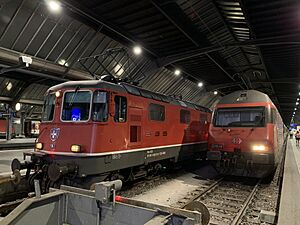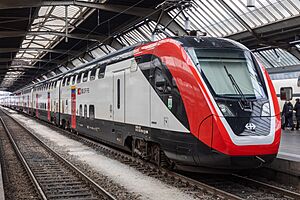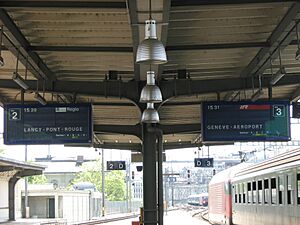Swiss Federal Railways facts for kids
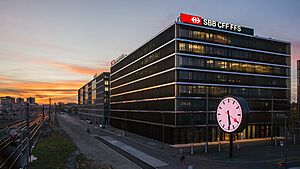
Head office in Bern
|
|
|
Native name
|
|
|---|---|
| state-owned AG/SA regulated by public law | |
| Industry | Rail transport |
| Founded | 1 January 1902 |
| Headquarters |
,
Switzerland
|
|
Key people
|
Vincent Ducrot, CEO Monika Ribar, chairperson of the board of directors |
| Revenue | |
| Total assets | |
| Total equity | |
|
Number of employees
|
|
| Divisions | Passenger, SBB Cargo, Infrastructure, Real Estate |
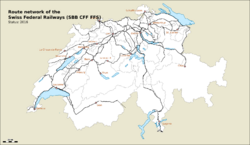
SBB network (for the whole Swiss railway network see: Rail transport in Switzerland)
|
|
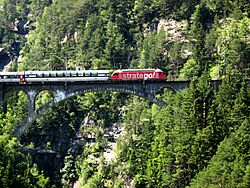
InterCity train on the old Gotthard Line
|
|
| Overview | |
|---|---|
| Dates of operation | 1 January 1902–present |
| Technical | |
| Track gauge | 1,435 mm (4 ft 8 1⁄2 in) standard gauge |
| Electrification | 99% 15, 1% 25 kV, 16.7, 50 Hz Overhead line |
| Length | 3,230 km (2,007.0 mi) |
Swiss Federal Railways (often called SBB, CFF, or FFS) is Switzerland's main railway company. It helps people and goods travel all over the country. The company started in 1902 and its main office is in Bern.
SBB is the biggest train and transport company in Switzerland. It runs trains on most of the country's railway lines. SBB also works closely with other transport companies. This helps create smooth and easy travel schedules for everyone.
In 2017, SBB was ranked as the best national railway system in Europe. This was because of how much it was used, its great service, and its high safety. While some European train companies focused on super-fast trains, SBB worked on making its regular trains very reliable and high-quality. Besides carrying passengers, SBB also moves cargo through its company called SBB Cargo. It also owns a lot of property in Switzerland.
Contents
What's in a Name?
The company is known by its initials in three official languages. These are German (SBB), French (CFF), and Italian (FFS). You might see it written as SBB CFF FFS or just by one set of initials. The official English short form is SBB.
There is also a Romansh name, Viafiers federalas svizras (VFF). Romansh is another language spoken in Switzerland. While this name is in official documents, the company itself does not use it.
How SBB is Organized
Swiss Federal Railways is split into different parts. These parts help manage the train services and other businesses.
Main Divisions
SBB has three main divisions that handle its daily operations:
- Passenger traffic: This part manages all the trains that carry people.
- Infrastructure: This division takes care of the railway tracks, signals, and stations.
- Real estate: This part manages all the buildings and land owned by SBB.
The part that used to handle cargo (called SBB Cargo) became its own separate company in early 2019.
Support Teams
SBB also has eight groups that help run the company and support the main divisions. These groups include:
- Finance: Manages the company's money.
- HR (Human Resources): Takes care of the employees.
- IT (Information Technology): Handles computers and technology.
- Communications: Manages how SBB talks to the public.
- Corporate Development: Plans for the company's future.
- Safety & Quality: Makes sure everything is safe and works well.
- Legal and Compliance: Handles laws and rules.
- Supply Chain Management: Manages how goods and services are bought and moved.
The Swiss government and SBB have an agreement that sets goals for the company. This agreement is updated every four years.
SBB also has smaller companies. For example, SBB GmbH operates passenger trains in Germany. Other companies like Thurbo and RegionAlps are also part of the SBB family.
In 2002, the Stiftung Historisches Erbe der SBB (SBB Historic) was created. This group looks after old trains and keeps important historical records.
SBB by the Numbers
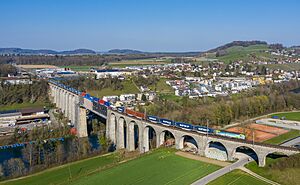
Here are some interesting facts about SBB from 2024:
- The railway network is about 3,266 kilometers (2,029 miles) long.
- All of SBB's railway lines are electric.
- SBB has 35,569 employees.
- About 1.39 million passengers travel with SBB every day.
- 93.2% of all passengers arrived at their destination on time or with less than three minutes of delay.
- SBB transports 43.1 million tons of freight each year.
- There are 311 railway tunnels, with a total length of 431 kilometers (268 miles).
- The longest tunnel is the Gotthard Base Tunnel, which is 57.1 kilometers (35.5 miles) long. This is a world record!
- SBB has 4,925 railway bridges, totaling 108.7 kilometers (67.5 miles) in length.
- The company uses 100% renewable energy for its trains.
SBB's rail network is completely electric. Its last non-electric line was closed for regular trains in 2004. It is now a special railway for historical trains.
A Look at SBB's History

In the 1800s, many different private companies owned Switzerland's railways. This led to a lot of competition, and some companies even went out of business. To fix this, the people of Switzerland voted in 1898 to create a railway company owned by the government.
The first train run by the Swiss government happened on New Year's Eve 1900. It traveled from Zurich to Geneva, passing through Bern. SBB officially started on January 1, 1902. Over time, more private railway companies joined SBB. The network has continued to grow ever since.
In 1999, Swiss Federal Railways became a special company owned entirely by the government.
In 1982, SBB started using a "clock-face schedule." This meant trains to certain places left every 60 minutes, making the timetable much simpler for everyone.
On December 12, 2004, SBB launched a big plan called "Bahn2000." This plan aimed to make train services even better. A key part was making travel times between major cities like Zurich, Bern, and Basel less than an hour. This made it much easier to connect to other trains. Many stations were rebuilt, and more trains were added. This was the biggest change to the timetable since the clock-face schedule began.
In 2005, there was a large power outage that stopped all trains in Switzerland during rush hour. About 200,000 people and 1,500 trains were stuck. This happened because the power network was overloaded.
Also in 2005, SBB received an award called the Wakker Prize. This award is usually given to towns, but SBB got it for taking great care of its historic buildings and stations. Many of SBB's buildings were designed by famous architects.
Since December 11, 2005, all trains and most SBB buildings became non-smoking areas.
In May 2010, SBB opened its first control center in Lausanne. This center helps manage all the trains in the French-speaking part of Switzerland.
The Famous SBB Clock
The Swiss Federal Railways clock is a famous symbol of Switzerland. It was designed by Hans Hilfiker. This clock is special because its second hand pauses for a little over a second at the top of each minute. It waits for a signal from a main clock to make sure all station clocks are perfectly in sync.
This unique design helps the railway run smoothly. Train timetables in Switzerland do not list seconds; trains always leave exactly on the full minute. All the clocks at a station need to show the exact same time for passengers and staff.
The station clocks get an electrical signal from a central "master clock" every minute. This signal moves the minute hand forward. The second hand moves on its own and takes about 58.5 seconds to go around. Then it stops briefly at the top, waiting for the next minute signal to start again.
Types of Trains
SBB offers different types of train services:
- Regio (R#): These are local trains that stop at all stations.
- S-Bahn (S#): These are commuter trains that run frequently in big cities. They are like a rapid transit system.
- RegioExpress (RE#): These trains stop only at certain stations within a region.
- InterRegio (IR#): These trains travel across two or three cantons (Swiss states) and are very common.
- InterCity (IC#): These trains stop only at major cities.
- ICN trains are a type of InterCity train that can tilt, allowing them to go faster around curves.
- Panorama Express (PE): These trains, introduced in 2019, are designed for tourists, offering great views.
- Special Trains (EXT): These are extra trains added when many people are expected to travel.
Some train services are run by other railway companies, including some that SBB partly owns. SBB also works with international train companies. For example, Deutsche Bahn (Germany's railway) operates Intercity Express (ICE) trains to and from Switzerland. The French company SNCF operates TGV trains to Switzerland under the name TGV Lyria.
Train Lines
Since 2018, SBB has used numbers and colors for its InterCity (IC) and InterRegio (IR) lines. This makes it easier for people to understand connections, much like a subway map.
InterCity Lines
InterCity (IC) trains are the main long-distance trains in Switzerland. They connect the country's biggest cities.
InterRegio Lines
InterRegio (IR) trains are semi-fast long-distance trains. They make more stops and are usually less expensive than InterCity trains. Some IR lines are operated together with other companies like Südostbahn (SOB) and BLS.
Regio Express Lines
Regio Express (RE) trains connect regions and are faster than local Regio trains.
Customer Services
SBB offers many services to its customers. SBB Digital works on new online services. For example, SBB has a co-working space in Zurich where people can work. SBB has won awards for its digital efforts.
SBB also works with airlines like American Airlines, Swiss International Air Lines, and United Airlines at Zurich Airport. This allows passengers to book train and plane travel together easily.
Languages Used by SBB
SBB uses three official languages: German, French, and Italian. In the Swiss canton of Grisons, where Romansh is spoken, the Rhaetian Railway (RhB) mostly serves that area. You will see "SBB CFF FFS" on trains.
Station names and signs are always in the local language of that place. If a city is bilingual, like Biel/Bienne, the station will have names in both languages.
Announcements at stations are usually in the local language. However, at busy stations like airports or tourist spots, announcements are also made in English. On trains, welcome announcements are made in all official languages of the regions the train travels through. On InterCity trains, English announcements are also made. When the train arrives at a station, the announcement is in the local language of that town. If a train travels through a bilingual city, the language of the announcement changes as the train passes through.
For example, the main station in German-speaking Zurich is signed as Zürich HB (short for Zürich Hauptbahnhof). But on websites and in announcements, you might hear its French, Italian, or English names.
Since 2002, SBB has used a special melody in its train announcements. The notes in the music come from the letters in SBB CFF FFS. This melody is played on a vibraphone. The melody changes slightly depending on which part of Switzerland the train is in.
See also
 In Spanish: Ferrocarriles Federales Suizos para niños
In Spanish: Ferrocarriles Federales Suizos para niños
- List of stock used by Swiss Federal Railways
- PostBus Switzerland
- Rail transport in Switzerland
- Public transport in Switzerland
- Gotthard Base Tunnel
- Lötschberg Base Tunnel
- Rail 2000


